Rediscovery and modern reception of the Black Obelisk
After the Black Obelisk of Shalmaneser III was unearthed in 1846 by Austen Henry Layard PGP 's excavators, the carved monument was shipped from Nimrud to the British Museum in London. Placed on public display in the museum, the obelisk quickly became famous for containing the depiction of an Israelite mentioned in the Bible - Jehu, king of Israel. Visitors flocked to the British Museum to see this amazing new find for themselves. The Obelisk continues to be an iconic monument today, with pictures appearing in popular books published across the world.
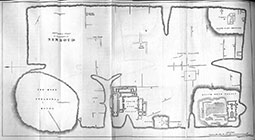
Image 1: Austen Henry Layard's plan of his excavations at Nimrud, from Nineveh and its Remains (1849) (1). Trench TT J, where the Black Obelisk was found, is shown next to "Central Palace". View large image.
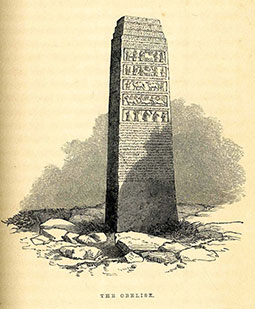
Image 2: The first image of the Black Obelisk, as it appeared in A. H. Layard's 1849 bestselling account of his expeditions, Nineveh and its Remains (2). View large image.
Discovery of the Obelisk
In 1846 Austen Henry Layard was excavating the site of Nimrud on behalf of the British Museum TT . The partial remains of two colossal bull TT sculptures appeared at the centre of the citadel mound, but the trench was deemed unprofitable. Layard describes how he discovered the Obelisk just as he was preparing to abandon further excavations in the area:
I ... had scarcely left the mound, when a corner of black marble TT was uncovered, lying on the very edge of the trench. This attracted the notice of the superintendent of the party digging, who ordered the place to be further examined. The corner was part of an obelisk, about six feet six inches in height, lying on its side, ten feet below the surface. ... On my return I found the obelisk completely exposed to view. I descended eagerly into the trench, and was immediately struck by the singular appearance, and evident antiquity of the remarkable monument before me. We raised it from its recumbent position, and, with the aid of ropes, speedily dragged it out of the ruins. (3)
Layard's published account of his excavations reports that the Obelisk was found in the middle of the citadel TT mound at Nimrud. This location is marked as Trench TT J on his 1849 plan of the excavation (Image 1) (4). During excavations the following year, Hormuzd Rassam found another broken obelisk (now called the "Rassam Obelisk") in the same area. The courtyard apparently served as a display area for royal monuments. The findspot TT can be clarified thanks to Polish excavations in the 1970s (5).
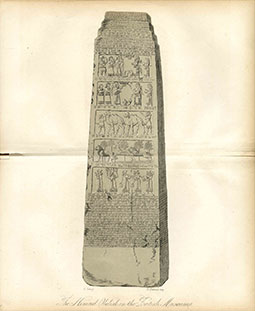
Image 3: Engraving by George Scharf made to illustrate Henry Rawlinson PGP 's study of the text on the Obelisk (6). View large image.
The Black Obelisk was sent from Nimrud to Baghdad by buffalo-cart and riverboat, as Layard himself describes:
I was again obliged to have recourse to the buffalo-carts of the Pasha TT ; and as none of the bas-reliefs TT and objects were of great weight, these rotten and unwieldy vehicles could be patched up for the occasion. On Christmas day I had the satisfaction of seeing a raft, bearing twenty three cases, in one of which was the obelisk, floating down the river. (7)
On arrival in Baghdad, the Obelisk's inscription was studied by Henry Rawlinson PGP , an East India Company TT officer with a keen interest in antiquities. The Obelisk then began the long journey to London, travelling via Bombay. It arrived at the British Museum in October 1848. Originally registered using the identification number 1848-11-4,1 it is now also now numbered ME 118885.
Biblical links and 19th-century interest in the Obelisk
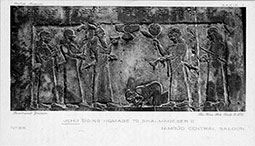
Image 4: This postcard depicts the scene on the Obelisk featuring biblical king Jehu. The buyer has underlined the name of Jehu. View large image. Image: private collection, CC-BY-SA 3.0.
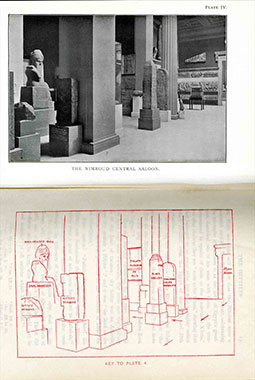
Image 5: A page from A. R. Habershon's The Bible and the British Museum (1909) featuring the Black Obelisk of Shalmaneser III in the 'Nimroud Central Saloon' gallery. Habershon's book was not an official museum publication but, rather, a commercially-produced 'unofficial' guide to objects that have Biblical siginficance. (8). View large image.
The obelisk was quickly put on public display at the British Museum in London and became a must-see object for visitors. In January 1849 the Trustees of the British Museum TT twice considered the best position for the Obelisk. A plan to place it in the central reception area at the main entrance was rejected. Instead the "Nimroud Obelisk" dominated the Museum's Nimroud Central Saloon gallery, surrounded by other Assyrian objects excavated by Layard at that site. Images of the Obelisk also began to circulate beyond the Museum's gallery. An engraving of the monument was included in Layard's bestselling account of the excavations Nineveh and its Remains (1849) (Image 2).
The Obelisk generated great excitement from the moment it was discovered. At first the completeness and length of the inscription was the primary interest. Rawlinson rushed to tell the public about the text. In January-February 1850 he explained his discoveries at length in talks at the Royal Asiatic Society TT , which were published along with a detailed engraving of the Obelisk (Image 3) (9). Among the figures identified by Rawlinson in the inscription was one "Yahua, son of Hubiri, a prince of whom there is no mention in the annals, and of whose country therefore I am ignorant" (10). However, it did not take long for Rawlinson and Edward Hincks, another pioneer Assyriologist TT , to identify this Yahua (now read "Iaua") as Jehu, the king of Israel who is mentioned in the Bible.
The link between the Black Obelisk and the Bible quickly became the main focus of scholarly and public interest. Jehu's image on the Obelisk (as shown in Image 4) is the earliest depiction of an Israelite. Jehu was not actually the son of Omri (Rawlinson's "Hubiri"), the founder of the Israelite PGP royal house. He had seized the throne from a son of Omri, and transferred his allegiance to Assyria. In around 841 BC Jehu sent as tribute TT to Shalmaneser "silver TT , gold TT , a golden bowl, a golden vase with pointed bottom, golden tumblers, golden buckets, tin, a staff for a king [and] spears". This episode is not recorded in the Bible, and so provided exciting new information on the famous figure. 19th-century interest in the Obelisk was further intensified by mention of Hazael, known from the Bible as king of Damascus.
Ada Habershon's The Bible and the British Museum (1909) (Image 5) provides a good example of the excitement which the Obelisk's Biblical ties generated:
The celebrated "Black Obelisk" (Plate IV., p. 17) stands in the centre of the Nimrood Saloon; and is of special interest, because it mentions two well-known Bible characters, Jehu and Hazael, the two whom Elijah was commanded to anoint, and to whom Elisha conveyed the news that they should rule over Israel and Syria. (11)
The Obelisk's popularity and copying
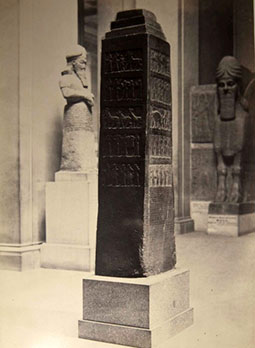
Image 6: The Black Obelisk displayed in the British Museum's Nimroud Central Saloon Gallery. Photograph by the Mansell company, 1872. View large image. British Museum photograph © The Trustees of the British Museum.
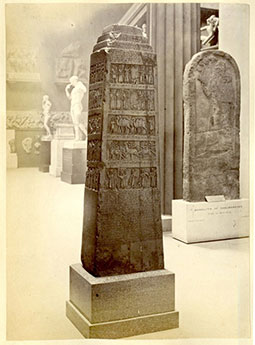
Image 7: Photograph by Frederick York, showing the Black Obelisk on display in 1876. View large image. British Museum photograph © The Trustees of the British Museum.
The 1855 Synopsis of the Contents of the British Museum declared the Obelisk to be "the most important historical monument as yet recovered from Assyria" (12). Thirty years later the Guide to the Exhibition Galleries of the British Museum stated, only slightly less excitedly:
Between the two central pilasters stands one of the most important historical monuments which have been recovered from Assyria, an obelisk in black marble, found near the centre of the great mound. (13)
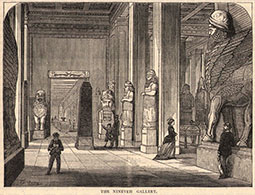
Image 8: A young boy marvels at the Obelisk on display in the British Museum. Engraving by P.W. Justyn, 1878. View large image. © The Trustees of the British Museum.
The museum's official 1886 Guide to the Nimroud Central Saloon dedicated no fewer than 20 pages to it (14). Other guides to the museum displays were produced by interested groups. The Rev. J.G. Kitchen's The Bible Student in the British Museum (1892) is a typical example. The book draws attention to the fact that Jehu and Hazael are mentioned in both the Obelisk inscription and the Bible, and concludes: "Thus the accuracy of Bible history is demonstrated" (15).
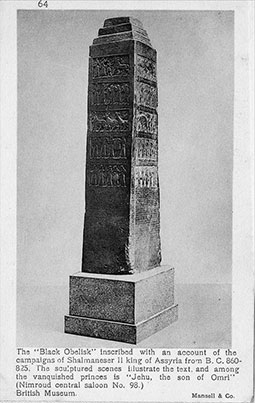
Image 9: A popular British Museum postcard of the Black Obelisk, produced by the Mansell company. Image: private collection, CC-BY-SA 3.0.
From the mid-19th century onwards, the British Museum experimented with techniques to make copies of objects widely available. Two common ways to do this were through photography and the production of replicas. Detailed images of the Black Obelisk were produced and sold in the late 19th century by suppliers such as the Mansell Company (Images 6, 7, 8). Through the 20th century, the monument was popular as a picture postcard on sale at the Museum (Images 2, 9). The craze for postcards was at its height between 1902 (when the UK Post Office first allowed the address and a message to be written on one side of the card) and the outbreak of the First World War in 1914. Although now long overtaken by newer technologies, postcards remain popular objects to send and collect.
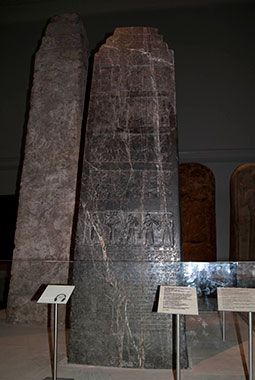
Image 10: The Black Obelisk displayed in Room 6 of the British Museum in 2013. BM 118885 [http://www.britishmuseum.org/research/collection_online/collection_object_details.aspx?objectId=367012&partId=1]. View large image. [/nimrud/images/obelisk/obelisk2013-large.jpg] © The Trustees of the British Museum.
Many replicas of the Black Obelisk were made for study and display purposes elsewhere. Already in February 1850 the Museum's Trustees ordered that a mould be made and casts sold for £3. In September 1851 the French government wrote to the British Foreign Office requesting squeezes TT of Assyrian antiquities in the British Museum collections; no. 16 on their wish-list was the Black Obelisk. Replicas continued to be produced on demand through the 20th century. In 1961, for example, the British Museum cast service offered anyone the chance to own a life-size copy for £30, or £36 waxed. A cast of the complete Black Obelisk was formerly exhibited in one of the Assyrian Halls of the Iraq Museum TT in Baghdad (16). Another cast appeared in the Hollywood re-imagining of king Priam's palace in Wolfgang Pedersen's 2004 film, Troy.
In the late 1950s the Obelisk was moved to the Assyrian Transept (today's Room 6), displayed alongside Assyrian sculptures. In the 1970s it was moved again, to the Nimrud Sculpture gallery (together with the "White Obelisk"). Around 1990 it returned to the Nimrud Central Saloon. In 2001 it was placed once more in what is now known as the Assyrian Sculpture Gallery (Room 6), where it now stands alongside the White Obelisk, and other Assyrian stelae and sculptures (Image 10).
Content last modified: 18 Dec 2019.
References
- Layard, A.H., 1849. Nineveh and its Remains, London: John Murray (free online edition at The Internet Archive), pp. 374 plan 1. (Find in text ^)
- Layard, A.H., 1849. Nineveh and its Remains, London: John Murray (free online edition at The Internet Archive), pp. 347 opposite. (Find in text ^)
- Layard, A.H., 1849. Nineveh and its Remains, London: John Murray (free online edition at The Internet Archive), pp. 346-8. (Find in text ^)
- Layard, A.H., 1849. Nineveh and its Remains, London: John Murray (free online edition at The Internet Archive), pp. 347 opposite. (Find in text ^)
- Mierzejewski, A. and R. Sobolewski, 1980. "Polish excavations at Nimrud/Kalhu", Sumer 36, pp. 151-162, pp. fig. 3. (Find in text ^)
- Rawlinson, H.C.R., 1850. "On the inscriptions of Assyria and Babylonia", Journal of the Royal Asiatic Society 12, pp. 401-483 (PDF available via JSTOR for subscribers), pp. 400-401, image between. (Find in text ^)
- Layard, A.H., 1849. Nineveh and its Remains, London: John Murray (free online edition at The Internet Archive), p. 372. (Find in text ^)
- Habershon, A.R., 1909. The Bible and the British Museum, London: Morgan & Scott (free online edition at The Internet Archive). (Find in text ^)
- Rawlinson, H.C.R., 1850. "On the inscriptions of Assyria and Babylonia", Journal of the Royal Asiatic Society 12, pp. 401-483 (PDF available via JSTOR for subscribers). (Find in text ^)
- Rawlinson, H.C.R., 1850. "On the inscriptions of Assyria and Babylonia", Journal of the Royal Asiatic Society 12, pp. 401-483 (PDF available via JSTOR for subscribers), p. 447. (Find in text ^)
- Habershon, A.R., 1909. The Bible and the British Museum, London: Morgan & Scott (free online edition at The Internet Archive), p. 20. (Find in text ^)
- British Museum, 1855. Synopsis of the Contents of the British Museum, London: Woodfall and Kinder (free online edition at The Internet Archive), p. 147. (Find in text ^)
- British Museum, 1884. Guide to the Exhibition Galleries of the British Museum, Bloomsbury, London: printed by order of the Trustees, p. 71. (Find in text ^)
- Renouf, P. Le Page, 1886. Assyrian Antiquities: Guide to the Nimroud Central Saloon, London: printed by order of the Trustees (free online edition at The Internet Archive), pp. 26-45. (Find in text ^)
- Kitchen, Rev. J.G., 1892. The Bible Student in the British Museum. A Descriptive Guide to the Principal Antiquities which Illustrate and Confirm the Sacred Histories, London, p. 62. (Find in text ^)
- Basmachi, F., 1975. Treasures of the Iraq Museum, Baghdad: Ministry of Information, pp. 241-42, 403, no. 148. (Find in text ^)
Further reading
- Layard, A.H., 1849-1853. The Monuments of Nineveh: From Drawings Made on the Spot, vols. I–II, London: John Murray (free online edition of vol. 1 and vol. 2), pp. plates 53-56.
- Mitchell, T.C., 1988. The Bible in the British Museum: Interpreting the Evidence, London: British Museum Publications, pp. 51-54, document 19.
- Reade, J.E., 1998. Assyrian Sculpture, London: British Museum Publications (2nd edition), pp. 62-64.
- Russell, J.M., 2003-2005. "Obelisk", in D.O. Edzard and M.P. Streck (eds.), Reallexikon der Assyriologie 10, Berlin: Walter de Gruyter, pp. 4-6.
- Smith, G., 1875. Assyrian Discoveries: an Account of Explorations and Discoveries on the Site of Ninevah, during 1873-74, London: Sampson Low, Marston, Low and Searle (free online edition at The Internet Archive), pp. 10-11.
- British Sign Language video about the Black Obelisk, available on the British Museum website. (Note that this is in British Sign Language only and has no subtitles).
Jonathan Taylor
Jonathan Taylor, 'Rediscovery and modern reception of the Black Obelisk', Nimrud: Materialities of Assyrian Knowledge Production, The Nimrud Project at Oracc.org, 2019 [http://oracc.museum.upenn.edu/nimrud/livesofobjects/blackobelisk/obeliskdiscovery/]